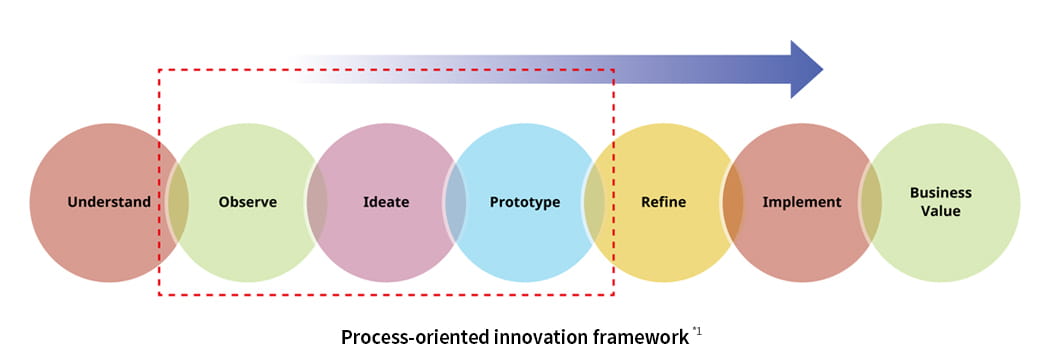
Marketing-driven Research
and Development
Our world is in chaos and we are on the brink of the fourth industrial revolution. In the business world, I see signs of a VUCA world emerging. A VUCA world refers to a world of Volatility, Uncertainty, Complexity, and Ambiguity. This term has been used often by people in the business world since a couple of years ago. The VUCA world is now the new normal and nobody can avoid it anymore.
Mega Trends and Game Changers
Taking the macro-viewpoint, there are a number of noteworthy mega trends. Take a look at
the upper layers of world affairs. You can see various trends, such as expansion of the
power of individuals, diffusion of power, change of population composition, and food,
water, and energy issues. They interact with and impact each other. There are also
several drivers that accelerate a change of game. They include a world economy that
frequently is in crisis, national governing power that is slow to respond to changes,
increasing probability of a clash of superpowers, growing regional conflicts, impact of
advanced technologies, and the changing role of the United States. Those elements can be
combined to generate various scenarios.
I am personally interested in topics such as food, water, and energy issues. We must
focus on global issues instead of national ones in order to start big new businesses.
The United Nations developed 17 goals in the 2030 Agenda for Sustainable Development
Goals, which include many challenges that Yokogawa and other companies should undertake
in order to contribute to creating social value.
Vision of Research and Development
When you consider those changes in the environment, there are two important concepts for research and development. The first one is design thinking. Design thinking refers to a system of steps from discovering a problem to solving the problem. It represents a transformation from the conventional approach of solving a problem through the virtual verification process to the approach of developing and solving a problem by identifying the root cause of the problem.
・Virtual verification: Analyzes a problem. Why does the problem occur?
・Design thinking: Identifies the root cause of a problem. Why is it a problem?
In an era when it is difficult to predict the future and the future is uncertain,
innovation activity must be carried out in parallel to current product development and
advance development activities to avoid biases from those developments. This innovation
activity is comparable to looking for a potential problem, compared to the conventional
approach of looking for an existing problem.
In addition, an innovation process framework, in other words, a thinking framework to
create solutions that produce innovation, is required (Figure 1). Its core is formed by
the three processes of OIP (Observe, Ideate, and Prototype).

The second concept is a transformation from R&D to C&D. R&D is the conventional research
and development, and C&D refers to connect & develop. For C&D, at an early stage you
must create a community with external stakeholders, such as customers and suppliers, and
develop and solve a problem in the co-creation process. This transformation to C&D will
become a driving force to create 1 from 0.
Furthermore, C&D will promote diversity. There are two kinds of diversity *2.
One is inherent diversity and the other is acquired diversity that is acquired through
experience. Inherent diversity includes elements such as gender, ethnicity, age,
religious background, sexual tendency, physical handicap, and nationality. On the other
hand, the acquired diversity elements include the level of cultural understanding,
cross-generational interaction, social media literacy, cross-professional knowledge,
global thinking, and language skills. This acquired diversity will play an important
role in research and development.
Conclusion
In a world in which it is getting more difficult to predict the future, we must first
deeply understand how to perceive and act and then think about what to do to further
develop these abilities.
In addition, a human-centered persona approach, such as support for collaboration
between human and environmental systems, will become a core aspect in global business in
our century.
It goes without saying that innovation is essential for business growth. And to
innovate, we must make our workplace a place that is open and diversified and is ready
to accept different opinions. Breaking free from regulations, we must work together with
business communities to provide a place where research and development is able to
actively create opportunities to move the world forward.
References
*1 : Adapted from IDEO (2017), 2nd Edition of the Human Centric Design Toolkit
*2 : Sylva Ann Hewlett, Melinda Marshall, et.al, “Innovation, Diversity and market
growth,” Center for Talent and Innovation, New York: Free Press, 2013
This is based on an article in the Yokogawa Technical Report (Vol. 60, No.1) that was authored by Tsuyoshi Abe, PhD, Senior Vice President, Head of Marketing Headquarters, Yokogawa.

